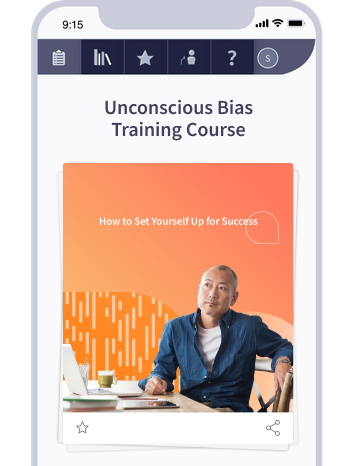We measure employees’ responses to social skills, so you can identify hot spots and hone in on skills that require further development.
Operationalize your data by rolling out targeted training. Deploy data driven content recommendations based on cutting edge organizational psychology trends.
Emtrain’s in-house video production team regularly produces new content and microlessons on an array of topics every quarter to hone skills that require further development.
We offer 20 minute and 30 minute course versions, or string a series of microlessons together for a more in-depth training program.
Get a preview of our industry-leading Managing Bias training video content that dives deep into the complex social issues of our time.

Biases are formed unconsciously through various influences such as upbringing, media, personal experiences, and societal stereotypes. They act as mental shortcuts our brains use when making decisions or judgments.
Biases can influence workplace decisions in many ways, including hiring practices, performance evaluations, promotion decisions, and daily interactions among colleagues. Recognizing how biases shape these decisions is crucial for promoting fairness.
Confirmation bias: Seeking information that confirms preexisting beliefs.
Halo effect: Allowing one positive trait to overshadow other traits.
Implicit association bias: Making snap judgments based on unconscious stereotypes.
Affinity bias: Favoring people who are similar to oneself.
Attribution bias: Assuming reasons for someone’s behavior based on limited information.
Unconscious bias often leads to microaggressions, which are subtle, often unintentional actions or comments that undermine feelings of inclusion and belonging among individuals.
Increase awareness through training and education.
Practice mindfulness and self-reflection to recognize personal biases.
Implement blind recruiting processes to reduce biases in hiring.
Encourage diversity and inclusion initiatives.
Establish clear policies and procedures to promote fairness and equity.
Emtrain’s Ask the Expert feature enables users to ask questions about compliance, bias, harassment, and inclusion as they come up. It’s all confidential, and answers are sent straight to their inbox.
When organizations talk about creating fair and inclusive workplaces, one of the biggest challenges is addressing unconscious bias in hiring....
It’s essential that organizations are recognizing the need for more than just technical skills. Creating a culture of respect, inclusion,...
In every workplace, small issues are often seen as just that—small. A missing pint of ice cream from the office...
Artificial intelligence (AI) is becoming a critical tool in the workplace, helping companies streamline processes, make data-driven decisions, and improve...
Unconscious bias in the workplace is a significant issue because it can lead to unfair treatment, limit opportunities for certain...
In today’s diverse and dynamic work environments, unconscious biases persistently undermine equality and fairness. These biases are automatic and unintentional,...